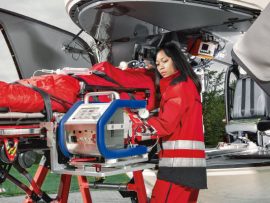Abstract Introduction Surgical safety checklists may contribute to reduction of complications and mortality. The WHO’s Surgical Safety Checklist (WHO SSC) could prevent incidents in operating theatres, but errors also occur before..
Read MoreAbstract Objectives To describe the incidence and outcomes of radiologically confirmed acute CNS complications in extracorporeal membrane oxygenation patients at an Australian extracorporeal membrane oxygenation referral center and identify associated..
Read MoreAbstract Since 2013, rotational thromboelastometry has been available in our hospital to assess coagulopathy. The aim of the study was to retrospectively evaluate the effect of thromboelastometry testing in cardiac..
Read MoreAbstract Recent advances in ECLS technology have led to the adoption of centrifugal pumps for the majority of patients worldwide. Despite several advantages of centrifugal pumps, they remain controversial because..
Read MoreTrends From 2002 to 2017 Extracorporeal life support (ECLS) has grown in its application since its first clinical description in the 1970s. The technology has been used to support a..
Read MoreAbstract It is observed that death rates in cardiac surgery has decreased, however, root causes that behave like triggers of potentially avoidable deaths (AD), especially in low-risk patients (less bias)..
Read MoreAbstract In patients with von Willebrand disease (vWD) the interest in age-related comorbidities has grown, because the life expectancy of these patients has increased. The research question of this study..
Read MoreAbstract The aim of the study was to describe the Mycobacterium chimaera contamination in heater–cooler devices after the application of a protocol of cleaning and disinfection in a tertiary hospital. It was..
Read MoreAbstract Background We describe implementation, evaluate performance, and report outcomes from the first program serving an entire metropolitan area designed to rapidly deliver extracorporeal membrane oxygenation (ECMO)-facilitated resuscitation to patients..
Read MoreAbstract We retrospectively reviewed the medical records of 11 patients supported with a veno-venous low-flow extracorporeal carbon dioxide (CO2) removal (ECCO2R) device featuring a large gas exchange surface membrane lung..
Read MoreAbstract Background Acute normovolemic hemodilution is recommended as a technique to reduce allogeneic red blood cell (RBC) transfusions in cardiac surgery, but its efficacy to reduce non‐RBC transfusion has not..
Read MoreAbstract OBJECTIVES The first aim was the development of a human blood miniature mock-loop system consisting of 2 identical extracorporeal circuits, which enable systematic head-to-head comparisons of test substances. In..
Read MoreAbstract Veno-arterial extracorporeal membrane oxygenation (VA ECMO) is widely used in cardiogenic shock. It provides systemic perfusion, but left ventricular (LV) unloading is suboptimal. Using a closed-loop, real-time computer model..
Read MoreAbstract Background Right ventricular (RV) dysfunction is a known risk factor for increased mortality in cardiac surgery. However, the association between RV performance and ICU morbidity is largely unknown. Methods..
Read MoreAbstract This article outlines recent developments in safety science. It describes the progression of three ‘ages’ of safety, namely the ‘age of technology’, the ‘age of human factors’ and the..
Read MoreAbstract Early cancer diagnosis, new therapies that increased survival of patients, besides the increasingly elderly population are some factors would be associated with possible cancer dissemination in patients under cardiopulmonary..
Read MoreAbstract AIM To investigate the incidence and risk factors for vancomycin concentrations less than 10 mg/L during cardiac surgery. METHODS In this prospective study, patients undergoing cardiac surgery received a..
Read MoreAbstract OBJECTIVES The invention of new surgical procedures requires testing at different stages including animal models. To facilitate this process, we have developed a computer-controlled extracorporeal circulation system for testing..
Read MoreAbstract OBJECTIVES Post-cardiotomy cardiogenic shock (PCCS) results in substantial morbidity and mortality, whereas refractory cases require mechanical circulatory support (MCS). The aim of the study was to compare extracorporeal membrane..
Read MoreAbstract OBJECTIVES Although total blood volume (TBV) is central to the estimation of the haemodilution rate during cardiopulmonary bypass (CPB), conventional formulas lack sufficient accuracy. The aim of this study..
Read MoreAbstract Background The objective of this study was to assess the incidence of in‐hospital acute kidney injury (AKI) after cardiac surgery by comparing preoperative baseline renal function with renal function..
Read MoreAbstract New threats to effective scientific communication make it more difficult to separate science from science fiction. Patients can be harmed by misinformation or by misplaced trust; for example, patients..
Read MoreAbstract The proportion of patients receiving intravenous gelatin‐based colloids has increased in the last decade due to safety concerns about starch‐based products. Recent research suggests hypersensitivity reactions to intravenous gelatin‐based..
Read MoreAbstract Aims To assess the associations between bullying and violence at work and cardiovascular disease (CVD). Methods and results Participants were 79 201 working men and women, aged 18–65 years and free..
Read MoreAbstract Background: Cardiac surgery is associated with peri-operative bleeding, which may result in the need for blood transfusion, particularly in paediatric congenital cardiac surgery on cardiopulmonary bypass (CPB). There is..
Read MoreAbstract The aim of the study was to evaluate the disposition of plasma unbound cefazolin in patients undergoing cardiothoracic surgery with cardiopulmonary bypass (CPB). Adult patients undergoing cardiothoracic surgery with..
Read MoreAbstract In this issue of the ASAIO Journal, Keane et al. present the results of their exploratory study on the combined use of whole body bioimpedance (WBB) and relative blood volume (RBV) monitoring..
Read MoreAbstract Background Fish oil is among the most common natural supplements for treatment of hypertriglyceridemia or prevention of cardiovascular disease. However, concerns about theoretical bleeding risk have led to recommendations..
Read MoreAbstract Background There is growing evidence regarding the importance of contextual factors for patient/staff outcomes and the likelihood of successfully implementing safety improvement interventions such as checklists; however, certain literature..
Read MoreAccording to the US Department of Health and Human Services, “Research misconduct means fabrication, falsification, or plagiarism in proposing, performing, or reviewing research, or in reporting research results.” Other important irregularities..
Read More




















